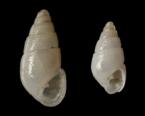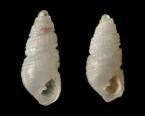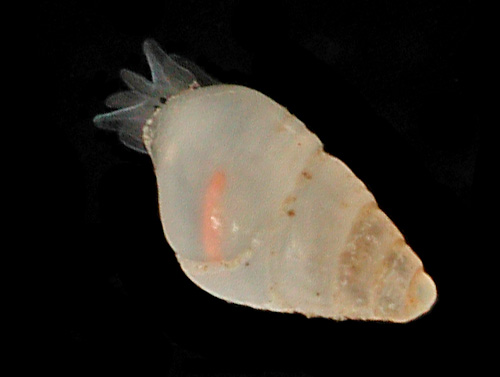| Home |
| Acknowledgments |
| Conventions |
| Glossary |
| Maps |
| References |
| Links |
| Articles |
| Thumbnails |
| Species
list |
| Family |
| Next
species |
Additional Photos

shell

shell, slender form

Evalea stearnsiella (Pilsbry, 1918)

| Maximum size: 3.4 mm shell
length. Identification: The shells of this species are relatively thick and conical. Young, unworn shells have prominent spiral cords on the apical whorls with the apical cords progressively more nodular and the abapical cord smooth. Mature shells usually show only a few narrow spiral striae on the latter whorls, possibly due to wear. There's a prominent, shelf-like fold on the columella and five or six ridges inside the aperture. The angle of coiling is variable. Natural history: Shells of Evalea stearnsiella are moderately common in beach drift. Live animals are occasionally found in shallow rocky habitats. According to Kay (1979), shells can be found in sand samples down to 40 m (131 ft). Distribution: Big Island, Maui, Oahu, French Frigate Shoals and Midway (also Johnston Atoll). Taxonomic notes: This species is listed in Kay, 1979 as Odostomia stearnsiella. It's probably also listed in Severns, 2011 as Odostomia kahoolawensis (the illustrated shell appears to be within the range of variation of young, E. stearnsiella and, in our opinion, Kay, 1979 was probably correct in synonymizing Odostomia kahoolawensis with O. stearnsiella). Kay, 1979 appears to be incorrect in suggesting that Odostomia syrtites is a synonym of Miralda scopulorum due to its greater number of basal cords. However, the illustration of that species in Pilsbry, 1918 and Severns, 2011 (as Miralda syrtites) may fall within the range of variation for young E. stearnsiella. It is also likely that the shells listed as Elodiamea sp. and Miralda cf. idalima (Melvill, 1896) in Severns, 2011 are this species with the latter referring to the slender form (see photo). The figure of the latter species in Melvill, 1896 shows more and finer spiral cords. John van Aartsen stated that he thinks the slender form may be a separate species. (pers. com). However, there appears to be a significant amount of intergrading in the angle of coiling. So, we're leaving them together pending further work. Photo: CP: Kahului Harbor, Maui; June 15, 2015. Observations and comments: Note 1: ( ) |
| Thumbnails |
Species
list |
Family | Next species | Top |